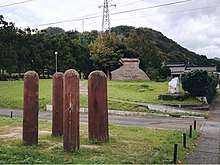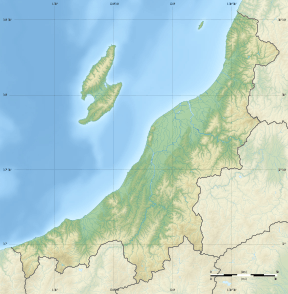Terachi Site
Terachi Site (寺地遺跡, Terachi Iseki) is an archaeological park containing the remnants of a Jōmon period settlement located in what is now part of the city of Itoigawa, Niigata in the Hokuriku region of Japan. The site was designated a National Historic Site of Japan in 1980.[1]
寺地遺跡 | |
 Terachi Site with reconstructed pit dwelling | |
 Terachi Site  Terachi Site (Japan) | |
| Location | Itoigawa, Niigata, Japan |
|---|---|
| Region | Hokuriku region |
| Coordinates | 37°01′30″N 137°48′34″E |
| Type | Settlement |
| History | |
| Founded | Jōmon |
| Site notes | |
| Ownership | National Historic Site |
| Public access | Yes |
Overview
The site encompasses five separate areas (designated Districts A through E) across a 150 meters east-west by 650 meters north-south coastal area of the Sea of Japan, near the west bank of the Taumi River, and contains the ruins of a large village from in the middle of the Jomon period (5,000 to 3,500 years ago). District B of the site was first discovered in the latter part of the Meiji period during construction work for the Hokuriku Main Line railway, and was partially excavated in 1968-1970. District A was discovered in 1966 and District C in 1965.
District B was found to contain seven pit dwellings, which were workshops for the mass production of jadeite stone axes and jade beads, magatama, fishhooks, spearheads and grinding stones. In addition to finished and semi-finished items, the site contained whetstones, abrasive sales and furnaces, indicating that these buildings were a complete production complex - one of the earliest to have been discovered in Japan.
Jade beads made at this site have been found throughout the Hokuriku region and into the Kantō region of Japan.
The site is open to the public as an archaeological park, with a couple reconstructed pit dwellings.
References
- "寺地遺跡" [Terachi Iseki] (in Japanese). Agency for Cultural Affairs.
External links
- Itoigawa City Tourist Information home page (in Japanese)